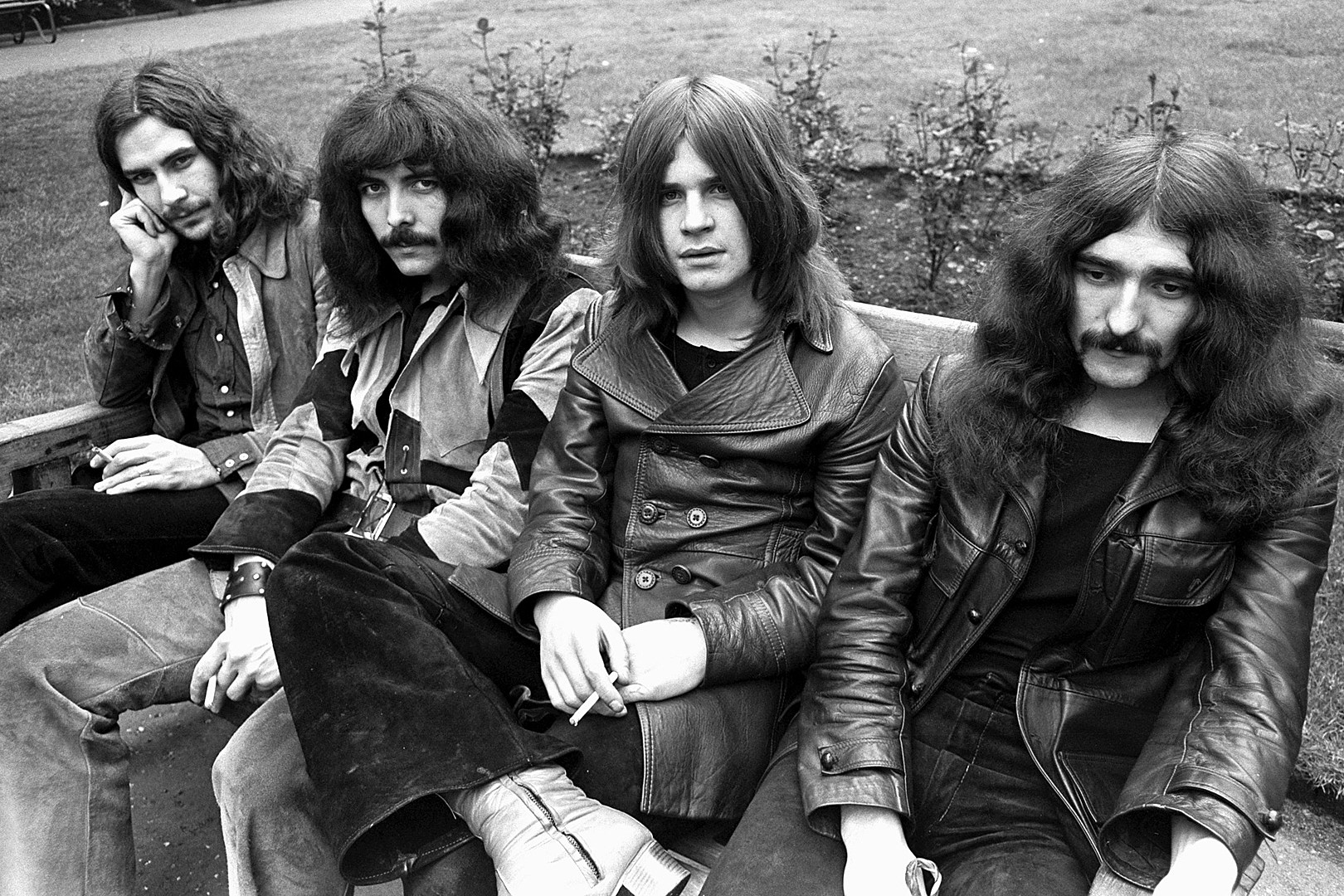Black Sabbath’s Formation and Rise: Black Sabbath, formed in Birmingham, England, in 1968, is widely regarded as the pioneering band of heavy metal. The original lineup consisted of John Michael “Ozzy” Osbourne (vocals), Tony Iommi (guitar), Geezer Butler (bass), and Bill Ward (drums). Emerging from a working-class industrial city, the band crafted a dark, heavy sound influenced by blues, jazz, and the grim realities of their surroundings. Iommi’s detuned guitar riffs—developed partly due to a factory accident that cost him two fingertip segments—combined with Butler’s occult-inspired lyrics and Osbourne’s raw, emotive vocals to create a groundbreaking style.

Their self-titled debut album, Black Sabbath (1970), recorded in a single day, introduced a menacing sound with tracks like “Black Sabbath” and “N.I.B.,” blending doom-laden riffs with themes of horror and the supernatural. The album’s raw energy and dark aesthetic resonated with audiences, charting in the UK and US. Their follow-up, Paranoid (1970), cemented their legacy with iconic tracks like “War Pigs,” “Paranoid,” and “Iron Man.” The album reached No. 1 in the UK and No. 12 in the US, selling millions and defining the heavy metal genre. Subsequent albums like Master of Reality (1971), Vol. 4 (1972), Sabbath Bloody Sabbath (1973), and Sabotage(1975) showcased evolution, incorporating progressive and experimental elements while maintaining their heavy core. By 1978, Black Sabbath had released eight albums, but internal strife, fueled by drug and alcohol abuse, strained the band.
Ozzy’s Departure and Solo Career: Tensions within Black Sabbath peaked in 1979, with Osbourne’s substance abuse leading to his dismissal. Replaced by Ronnie James Dio, Osbourne was written off by many. However, he rebounded with a solo career, launching Blizzard of Ozz (1980), featuring guitarist Randy Rhoads. Hits like “Crazy Train” and “Mr. Crowley” showcased a revitalized Osbourne, blending melody with metal aggression. His solo work continued with albums like Diary of a Madman (1981) and Bark at the Moon (1983), establishing him as a solo icon. Osbourne’s theatrical live performances—infamously including biting the head off a bat in 1982—cemented his “Prince of Darkness” persona. Despite personal struggles, including addiction and legal battles, he released successful albums like No More Tears (1991) and Ozzmosis (1995), selling over 100 million albums as a solo artist.
Black Sabbath’s Evolution and Reunions: Post-Osbourne, Black Sabbath continued with Dio, releasing Heaven and Hell (1980) and Mob Rules (1981), both critically acclaimed. The band cycled through vocalists (including Ian Gillan and Glenn Hughes) and faced lineup changes, with Iommi as the constant. Albums like Born Again (1983) and Seventh Star (1986) met mixed reception, and by the late 1980s, the band’s commercial success waned. A partial reunion with Dio in 1992 produced Dehumanizer, but stability remained elusive.The original lineup reunited in 1997 for Ozzfest, Osbourne’s music festival, leading to the live album Reunion(1998) and new tracks like “Psycho Therapy.” However, health issues and conflicts persisted. In 2011, the original members announced a full reunion, resulting in 13 (2013), their first studio album with Osbourne since 1978. Bill Ward was absent due to contractual disputes, with Brad Wilk drumming. The album hit No. 1 in multiple countries, proving their enduring appeal. Their final tour, The End (2016-2017), marked Black Sabbath’s retirement from touring, with Osbourne, Iommi, and Butler performing.

Ozzy’s Later Years and Legacy: Osbourne’s solo career persisted despite health challenges, including a 1991 Parkinson’s-like diagnosis (later clarified as a related condition) and spinal injuries from a 2003 ATV accident. His 2020 album Ordinary Man and 2022’s Patient Number 9 earned critical praise, the latter winning two Grammys. Osbourne’s reality TV show, The Osbournes (2002-2005), broadened his fame, showcasing his family life with wife Sharon and children Kelly and Jack.Black Sabbath’s influence on heavy metal is immeasurable, inspiring bands like Metallica, Slipknot, and Pantera. Osbourne, both with Sabbath and solo, became a cultural icon, known for his resilience, controversial antics, and unmistakable voice. The band sold over 70 million albums, while Osbourne’s solo catalog exceeds 100 million. Despite personal and professional turmoil, their legacy endures as architects of a genre and symbols of rock’s rebellious spirit.
Black Sabbath, formed in Birmingham, England, in 1968, is widely credited with inventing heavy metal, with Ozzy Osbourne’s raw vocals and the band’s dark, heavy sound defining the genre. The quartet—Osbourne (vocals), Tony Iommi (guitar), Geezer Butler (bass), and Bill Ward (drums)—emerged from the industrial, working-class grit of Birmingham, channeling their environment’s bleakness into a groundbreaking sound.
Their journey began as the Polka Tulk Blues Band, playing blues-rock inspired by Cream and Led Zeppelin. Renamed Earth, then Black Sabbath after a 1963 horror film, they shifted toward a darker aesthetic. Iommi’s detuned guitar riffs, necessitated by a factory accident that severed two fingertips, created a sludgy, ominous tone. He tuned his guitar down to reduce string tension, producing the heavy, doomy sound that became their signature. Butler’s basslines, inspired by Jack Bruce, added weight, while Ward’s powerful drumming drove the rhythm. Osbourne’s untrained, wailing vocals, conveying raw emotion, completed the mix, setting them apart from the era’s psychedelic optimism.
Their 1970 debut, Black Sabbath, recorded in a single day, introduced the world to heavy metal. The title track, built on Iommi’s tritone riff (the “diabolus in musica”), combined with rain and church bell effects, created a haunting atmosphere. Lyrics, mostly by Butler, drew from horror films, occult themes, and social issues like war and alienation, resonating with a generation facing Vietnam and Cold War tensions. Paranoid (1970), their follow-up, refined this sound with tighter, more accessible songs like “War Pigs,” “Paranoid,” and “Iron Man.” The album’s raw energy, heavy riffs, and socially conscious lyrics solidified their influence, hitting No. 1 in the UK and selling millions.

Sabbath’s sound evolved through albums like Master of Reality (1971) and Sabbath Bloody Sabbath (1973), incorporating progressive and experimental elements while staying rooted in heavy, riff-driven music. Their influence shaped subgenres like thrash, doom, and stoner metal. Osbourne’s charismatic, unpolished stage presence made him the face of the band, though his 1979 firing due to drug issues led to a successful solo career, starting with Blizzard of Ozz (1980). Black Sabbath continued with other vocalists but reunited with Osbourne periodically, proving their original chemistry was unmatched.By blending Iommi’s innovative guitar work, the rhythm section’s intensity, Osbourne’s distinctive voice, and dark, socially relevant themes, Black Sabbath didn’t just find their sound—they created heavy metal, leaving an indelible mark on music history.


